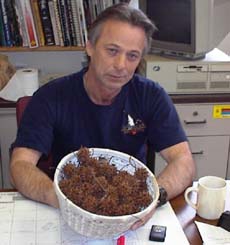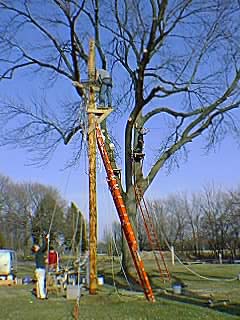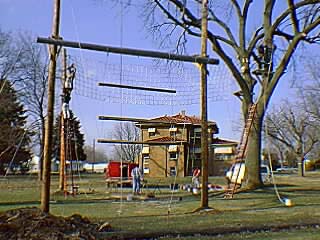

|
[MARCH 9, 2000] The brown fruit of the sweet gum tree is creating problems for local homeowners. The sweet gum tree is a tall, stately tree that grows throughout most of the United States, with Central Illinois being at the northernmost perimeter of its region. Its fruit is a brownish spiny ball that remains on the tree throughout the winter. This fruit plugs up drains, continuously litters yards and is a big nuisance, says Don Osborne, street superintendent of Lincoln. “The city’s policy has been not to remove trees unless they are dead, diseased, dying or dangerous,” he continued.
|
||||||||||||||||
|
There is no chemical control currently labeled in Illinois for preventing the formation of sweet gum balls. There are a few compounds available that will cause some abortion but it is costly, hard to apply and again not registered for use in Illinois. For those residents who are adamant about removing their sweet gum tree, there may be a remedy. An Illinois group of old-house enthusiasts says the only control to prevent sweet gum balls from forming is a chain saw used at ground level. The city of Lincoln may now agree. Osborne mentioned, "We don’t want to get to the point where residents are just removing trees." But due to the number of complaints received from residents with sweet gum trees on their property, the city’s forestry committee has made a recommendation to the city council to try to alleviate this problem for residents.
Osborne said, "If the recommendation is approved, residents would have to first obtain a free permit from city hall and agree to bear the full cost for the tree removal. They would also have to pledge to replant a tree in the same or surrounding area. The exception to replanting would be if the tree would have a negative impact, such as on utilities, blocking the view at an intersection or some other legitimate reason for not replanting. The city of Lincoln has a list of prohibited and acceptable trees that can be used to replenish the trees that may be cut down. Tree replacements can be picked from this list such as oaks, several varieties of maples and others."
|
The sweet gum tree produces a gummy compound called stroax that is used in making perfumes, adhesives and salves. Sweet gum wood is fairly hard and heavy. It is often used to make veneer, cabinets, boats, toys, boxes, fuel and other products. The leaves are star-shaped, with a pleasant fragrance when crushed. The bark is deeply furrowed into narrow scaly ridges; hence another common name, the alligator tree. The sweet gum tree is a common broadleaf tree, a good shade tree, and amongst the most brilliant in autumn. Native Americans and early pioneers chewed the hardened clumps of sap that exuded from the bark of the tree when cut. They used it for medicinal purposes, as chewing gum and with some tree varieties as a breath freshener.
Local lore says a Lincoln naturalist who obtained the trees as seedlings brought the sweet gum trees to Lincoln in the early to late 1960s. He then gave them to the city of Lincoln to plant.
|
|||||||||||||||
|
[MARCH
9, 2000]
Positive Actions
Relating to Youth, or P.A.R.T.Y., will bring seventh
graders from all over Logan County to the campus of
Lincoln Christian College on Friday, March 10.
They will attend 10 workshops presented by high
school students from Mount Pulaski, Hartsburg-Emden and
Lincoln Community High School.
These students will use skits and drama to show the
seventh graders what to expect in high school, exploring
such issues as dating and friendship, laws that impact
young people, violence in schools and what it’s like
driving after you’ve been drinking.
|
||||||||||||||||
|
Motivational speaker Ben Glenn will give a presentation on setting goals and avoiding drug use, including a chalk drawing and light show. Parents, teachers, Lincoln Christian College staff members, the Logan County Health Department, the Lincoln Police Department, the University of Illinois Extension Service and other community agencies will assist with the program.
|
The Logan County Health Department sponsors P.A.R.T.Y. Funding is made available by T.O.U.C.H. (Teaching Others Using Chemicals Hurts), through donations from United Way, Rotary, Kiwanis and other supporting individuals. Registration for the P.A.R.T.Y. begins at 8:30 a.m. tomorrow with the final session ending at 2:20 p.m. [LDN] |
|||||||||||||||
|
High-Ropes Challenge Course—a Peak Experience [MARCH
8, 2000] The
Lincoln Area YMCA’s Gateway program is a very
“uplifting” experience for youth ages 12 to 15. In
fact, some lucky youngsters will be lifted nearly 30 feet
in the air at the Y’s high-ropes challenge course
located behind the Y office at 319 West Kickapoo.
|
||||||||||||||||
|
Cliffs ’n Cables, a Chicago-based company that specializes in outdoor adventure courses, finished constructing Lincoln’s ropes course in February. The YMCA’s new structure includes a high-ropes course (suspended between trees and poles 30 feet in the air), a low-ropes course (just a few feet off the ground), and a team rescue course (you would have to see it). The Y’s ropes courses are constructed of wood, cables and rope. The high-ropes course includes a cargo net, Burma bridge, bottomless Burma bridge, balance beam, vine walk and a zip line. Sounds like the perfect adventure for any rambunctious early adolescent.
What is the purpose of the YMCA’s challenge courses? According to Angie Peters, executive director of the Lincoln Area YMCA, challenge courses "teach teamwork and enhance a young person’s self-confidence." As would be expected in any YMCA program, participants are carefully trained and supervised. "The challenge courses are very exciting, but also very safe," explains Peters. The equipment is tested and certified before we use it. The staff is thoroughly trained. The kids are always connected to safety lines. At all times, the participants are part of carefully designed instructional activities that teach important lessons. This isn’t just a recreational experience."
|
The first group of Gateway youngsters to ascend the trees will be eighth graders from Lincoln Junior High School. These students are completing the Prudential Youth Leadership Institute training, which they received from YMCA staff members, Ron Sillings and Sarah Farris. The nationally validated program teaches communication, leadership, and community service. A reward for completion of the program (including a successful community service project) will be an invitation to participate in the challenge courses training. "Kids in Lincoln are getting the advantage of training that corporations spend a lot of money on to provide their executives," says Sillings. "I’m talking about both the Prudential Youth Leadership Institute and the challenge courses. The Prudential program is based on a corporate training model, with an added community service dimension. Ropes courses are very common training experiences for executives." In the months to come, the Lincoln Area YMCA will open its challenge course training to church, corporate, school, club and family groups. The Gateway project will expand to serve other groups of 12 to 15 year olds. Gateway has been generously supported by two local and anonymous contributors.
|
|||||||||||||||
|
Zion Lutheran School Celebrates National Lutheran School Week [MARCH 7, 2000] Zion Lutheran School, located at 1600 Woodlawn Road, is celebrating National Lutheran School Week. This year’s theme is, "Shine Like Living Stars." Students of all ages began the event-filled week with yesterday’s Hobbies and Careers Day. The PTO organized a day’s worth of activities to expose the students to nearly 50 different professions.
|
||||||||||||||||
|
Field trips to visit businesses on site included: Logan Lanes, Kroger, Wendy’s, Elder Custom Cycle, The Courier, Lincoln Animal Clinic, Christian Village, Cracker Barrrel, Graue Chevrolet, Archery and Hunting Club, and Photography with Debbie Skelton. Other area business persons brought their craft to Zion. Activities and presenters were: Mapmaking with Kim Larson, Candy Making with Cindy Ayars, Swing Dance with Audra Turley, Wire Beads with Laura Davidson, Rope Making with Edgar and Analina Coers, Truck Driving with Dennis Rekart, Cake Decorating with Roberta Rademaker, Counted Cross Stitch with Pam Conrady, Woodworking with Peggy Meyer, Amazing Science with Mr. Boyd, Farm and Home Safety with Betsy Pech, Rubber Stamping with Judy Awe, First Aid with Marsha Dowling, Theater Workshop with Vicki Brinton, Eye Care with Dr. Nobbe, Farming with Jim Drew, Finger Weaving with Fay Boerma, Hair Care with Paula Landess, Air Brush Painting with Tom Alberts, Creative Memories Scrapbooking with Carol Runyon, Tae Bo with Carla Bender, and Magicians with Chris Sprinkle. Baby-Sitting, Antiques Show, Bass Fishing Skills, Civil War Costumes, Paper Quilting, Race Car Engines and Skin Care were also showcased.
|
At 10 this morning an Illinois Air National Guard helicopter landed in front of the school. Later today students will present a talent show. The schedule for the remainder of the week is as follows:
Other activities scheduled for this week include Blue and Gold Day, Walking Art Day (students will wear T-shirts they have made), and Shorts in March Day. [LDN]
|
|||||||||||||||
|
Police Ask Citizens’ Help to Combat Meth Labs [MARCH 7, 2000] The methamphetamine labs that are a growing problem in Central Illinois pose many different hazards, according to Master Sergeant Bruce Liebe of the Illinois State Police. Ingredients used to make the drug can maim or even kill. The labs are a fire hazard, and the toxic waste they produce is destructive to the environment and costly to clean up.
|
||||||||||||||||
|
In addition, the drug is so addictive that it completely dominates the lives of users. "Their whole lives revolve around the drug," Liebe said at a seminar held yesterday at the Lincoln Park District. "Their children don’t matter, their relationships don’t matter, their work doesn’t matter. All that matters is meth." To fight this problem, law enforcement agencies in Illinois are asking for help from people in the community. Because the drug can be made entirely from legal substances that are easy to get, police would like farmers, merchants and ordinary citizens to report thefts or large purchases of substances meth "cooks" need. There is more than one recipe for the drug, Liebe said, but all of them start with common over-the-counter cold and asthma medications containing ephedrine or pseudo-ephedrine. Piles of empty bubble-packs that once held these pills could be one sign that a meth lab is in the neighborhood. Although one person can legally buy only two packets of these pills at a time, a meth manufacturer can visit more than one store, until he or she has accumulated the thousand pills used to make an average batch of the drug. Merchants who notice large and frequent purchases of these products should inform the local police department and if possible give a physical description of the purchasers. The most popular meth recipe in Central Illinois uses anhydrous ammonia, a liquid fertilizer. Right now there are many tanks of anhydrous sitting in farmyards and fields ready for spring use. Farmers who think the tanks may have been tampered with should notify authorities, and if they see a suspicious car in the vicinity should make a note of the license number. Lithium batteries are another staple, along with a solvent such as ether, starter fluid, fuel for a camp stove or a similar substance. Another ingredient is hydrogen chloride gas made from sulfuric acid. Some recipes also use red phosphorous and iodine crystals, muratic acid, freon, acetone, hydriotic acid and denatured alcohol. Any merchant who sees an increase in sales of products containing these chemicals should also inform the local police department. The contents of garbage cans sometimes provide clues to the presence of a meth lab, Liebe explained. Empty containers of starter fluid, ether cans with holes punched in them, products such as Heet, drain cleaner cans, salt containers and stripped-out lithium batteries indicate meth is being produced nearby. Other clues are coffee filters and used glass containers containing white residue (sometimes pink if that was the color of the pills the cook started with).
|
A pervasive odor of ether or a strong smell of ammonia can also indicate a meth lab in the area, he said. Every pound of meth produces five or six pounds of very toxic residue, Liebe said, and meth users are not careful how they dispose of it. Toxic waste has been dumped in farm waterways and fields where it kills fish, animals, and all vegetation. Often it is put in dumpsters or even city sewers. The cost to clean up the average meth lab, which must be done by a hazardous waste contractor, is from $5,000 to $10,000. Manufacturing meth is a dangerous occupation. "Most anhydrous thieves have some type of injury," Liebe explained. The volatile liquid can cause burns on the hands and face and, if accidentally splashed in the eyes, blindness. He noted that if a quart of the ether used in the meth manufacturing process is ignited, "It could blow up a small house." The hydrogen chloride gas is also very deadly. "A little can put you down and a little more can kill you, and those makeshift labs usually aren’t properly ventilated." The meth labs don’t look like a science setup with sophisticated equipment, he pointed out. Blenders, hot plates, plastic bottles, glass jars, duct tape and plastic tubing like that used in an aquarium are common utensils. Most of the equipment needed to make meth can be stored in a small space, such as a chest cooler. In Illinois the first users were adults in their 30s and 40s, according to Lincoln police, but the recent raid on a meth lab in the San Jose area turned up users of high school age as well. "There is more and more use in this age group," Liebe said. Sometimes it’s like raiding a school bus." "We are so concerned about this that we’ve dedicated an officer from our police force to work on the drug problem," said Lincoln Police Chief Richard Ludolph. "He works in the District 9 area of Central Illinois with state Drug Enforcement Administration." Ludolph said that Illinois legislators have toughened the laws and the prosecutors are now able to get stiffer penalties for drug manufacturers. "Overall we are fortunate we live in Logan County when it comes to drug sentencing," he said. "Our legal system here has always aggressively prosecuted drug dealers, much more aggressively than in some other counties in Central Illinois. We have sent some to prison for 10 to 15 years." The informational seminar was sponsored by the Alcohol, Tobacco and Drug Task Force of the Healthy Communities Partnership. A second seminar is scheduled for Monday, March 13, at 6:30 p.m. at Lincoln Junior High School, 208 Broadway.
|
|||||||||||||||










